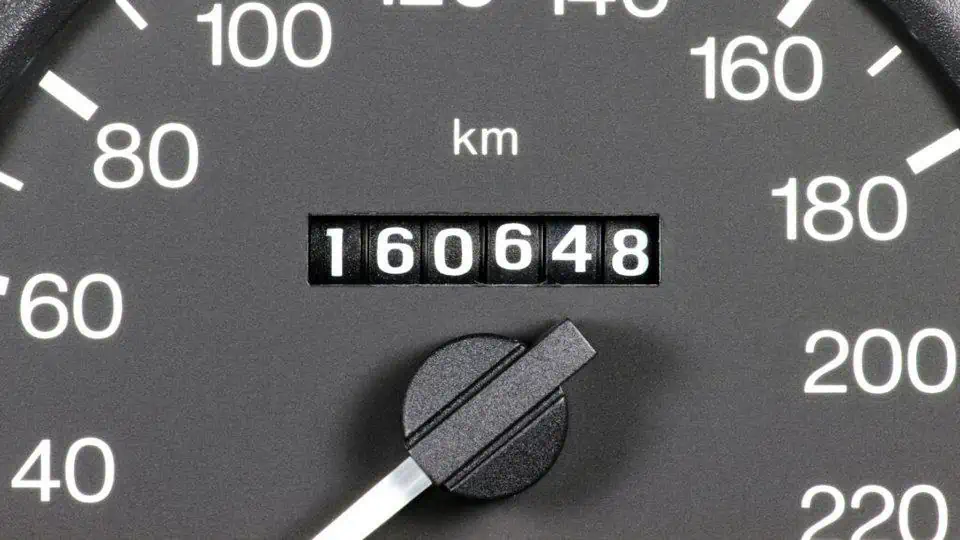How Many Miles Can a Car Last?
A car can last between 80,000 and 300,000 miles, depending on its make, model, and usage. Modern cars, benefiting from technological advancements, tend to last longer than older ones.
On average, a modern car is expected to reach around 200,000 miles, equating to about 15 years of usage if driven 10,000–13,000 miles annually.
Electric cars, due to fewer mechanical issues, can potentially last up to 300,000 miles. In contrast, cars from earlier decades often reached only 80,000 to 100,000 miles before needing replacement.
Improvements in parts, such as the shift from rubber timing belts to more durable metal timing chains, and more efficient, precise factory production techniques contribute to the increased longevity of modern vehicles.
Factors That Affect a Car’s Lifespan
The fact that modern cars usually last for 200,000 miles doesn’t mean that ALL modern cars will last the same. Plenty of factors go into determining a car’s lifespan. Here’s a roundup:
1. Maintenance
It’s not an easy fact to swallow, but cars are in a constant state of depreciation. That’s why they need regular maintenance. It’s not only necessary for your own safety but for the car’s life expectancy as well.
Sludge buildup in the engine can wear it down and cause it to work less efficiently, which not only reduces its lifespan but also makes it use more gas.
On top of that, the timing belt can cause severe damage to the entire engine if it snaps.
The key to avoiding these issues is to stick to your car manufacturer’s suggested maintenance schedule. Don’t miss the periodic 5000-mile appointments. Catching an issue early can be the key to getting more miles out of your car.
2. Driving Habits
Do you tend to slam your brakes constantly and speed through city streets like you’re chasing someone? If it’s legal, you can do it all you want, but keep in mind that similar driving habits can take a few years off your car’s life expectancy.
Practices like weighing down your car and punching the gas suddenly can cause your engine to wear out faster than it should. If you want your car to keep servicing you, it’s better to stick to smooth sailing.
3. Build Quality
Unfortunately, there are some factors that you can’t control, like the build quality and reliability of your car.
Some car models are known for their insane reliability, and some are known for not lasting long on the streets. It depends on the quality of the parts and chassis, which is something you can’t change.
Before buying a car, it’s better to do deep market research and learn about the life expectancy of the model in your mind. No matter how much you care for your car, some cars won’t last long.
7 Best High-Mileage Cars

While mileage isn’t the sole factor that affects a car’s condition, you still want to seek a vehicle that will be well worth the investment, whether you’re on the hunt for a used or new vehicle.
Here are a few of the best high-mileage cars that are likely to get you beyond 200,000 miles with proper maintenance:
- Honda Civic
- Ford F-150
- Toyota Camry
- Toyota Corolla
- Honda Accord
- Chevy Equinox
- Subaru Legacy
If you’re seeking a vehicle for your ridesharing gig, you can compare these vehicles to what’s recommended in our guide about the best cars for Uber.
4 Tips to Help Your Car Last Longer
So what exactly does it mean to take care of your car?
In order for your vehicle to go beyond the 200,000-mile average, you must be proactive about your car’s needs as soon as you take it home from the dealership.
Here are four tips to help you with your car care:

Every car owner should be following a set car maintenance schedule, so you’re always preventing issues instead of spending hundreds of dollars to fix them.
This schedule should include:
- Getting an oil change every 3,000 miles
- Cleaning car battery terminals every 6,000 miles
- Getting tires rotated every 6,000 miles
- Keeping your vehicle clean inside and out every two weeks, or when needed
Car maintenance should also involve regular inspections, so you can catch any present issues before they truly damage your engine or other parts of your vehicle.
You can check your fluid levels — including your coolant, transmission fluid, and engine oil levels — as well as your tire pressure and lights straight from home.
For more complex inspections, like brake system and wheel alignment checkups, you can simply head to a professional once per year.
You can use our suggested car maintenance schedule, specifically tailored for rideshare and delivery drivers, as your complete guide.
2. Diagnose and Fix Issues Quickly
Of course, your car maintenance schedule is a method of prevention and not a guarantee that issues won’t occur.
While your vehicle is built to last for many miles, specific car parts like your car battery will naturally die out in half the time.
The best way to ensure that these issues don’t affect the rest of your vehicle is to pay attention to how your car drives and head to the repair shop as soon as you notice an issue.
Some common signs of car problems to look out for include constantly decreasing fluid levels and strange noises like rattling or squeaking.
You also definitely don’t want to let your check engine light sit for long.
3. Invest in Quality Parts

When you do need to replace parts of your car, it pays to invest in high-quality parts, including better tires and longer-lasting batteries.
This will ensure that fewer replacements are needed over time.
You also want to make sure you’re always using manufacturer-recommended parts, instead of using alternatives just to save.
Using regular fuel instead of premium on some car models, or using the wrong type of engine oil, can even damage a new car or low-mileage vehicle quickly.
Always consult your owner’s manual or an expert for the best parts to use for your car.
4. Drive Safely
When you’re a rideshare or delivery driver, you’re already practicing severe driving, which involves driving in stop-and-go traffic and frequent idling.
Since your the nature of your gig doesn’t always allow you to drive gently, you don’t want to add more strain to your vehicle.
Keeping up with safe driving habits is the best way to keep your vehicle healthy for as long as possible.
Start accelerating and braking gently, and only make gradual turns — rideshare passengers will thank you for it, too.
When you’re not waiting for passengers to arrive, or when you’re off the clock, avoid leaving your car running when you’re just sitting in your vehicle.
As always, you should be practicing defensive driving to avoid dangerous, costly accidents caused by weather, other drivers, pedestrians, or you.
Frequently Asked Questions
There’s no one answer to our initial question — “How many miles can a car last?” — but there are definite tactics you can use to extend your car’s lifespan.
To learn more about keeping your low-mileage and high-mileage vehicle alive, read our answers to these common questions:
What are some signs of poor car maintenance that I should look out for when used car shopping?
If you notice any signs of rust or corrosion throughout a vehicle while used car shopping, this can be a sign of poor maintenance and buildup overtime.
Even if it’s not presently causing any major issues, it could quickly lead to some.
You should also look out for paint overspray, which can indicate that repairs were needed.
Asking your dealership for a vehicle history report can also give you better insight into a car’s condition.
Is there a maximum mileage that I should look out for when shopping for a used car?
Many car shoppers avoid buying cars that have 100,000 miles or more, so they can keep driving their vehicles for as long as possible.
However, as we’ve highlighted in this article, mileage isn’t always a major factor if you see clear signs of regular maintenance, like an engine that’s still like new after many years.
Plus, our recommended high-mileage car models frequently last for double (sometimes triple) the amount of time that an average car lasts, so they can be safer bets if you don’t have the budget for a newer car.
At what point should I be seeking a new car?
If your car is getting to the point where repairs are nearing the cost of a new purchase, or repairs are no longer keeping your car issue-free for long, it may be time to go car shopping.
Most car owners are keeping their vehicles for an average of six years — though you can definitely keep it for longer when you stick with a schedule — so don’t feel like you’re stuck with your car until it’s completely useless.
Wrapping Up
So, how many miles a car can last?
A car can last anywhere from 80,000 to 300,000 miles, depending on how well you treat it and how old it is.
Older cars have older mechanical systems, so they’re prone to more trouble than modern cars. Consequently, that means they’ll give you lower mileage.
Meanwhile, modern cars are wired to last for 200,000–300,000 miles if you treat them right.
Make sure to stick by your maintenance schedule and keep your driving habits in check. You never know; getting rid of a nasty habit may buy you two or three more years of mileage.






